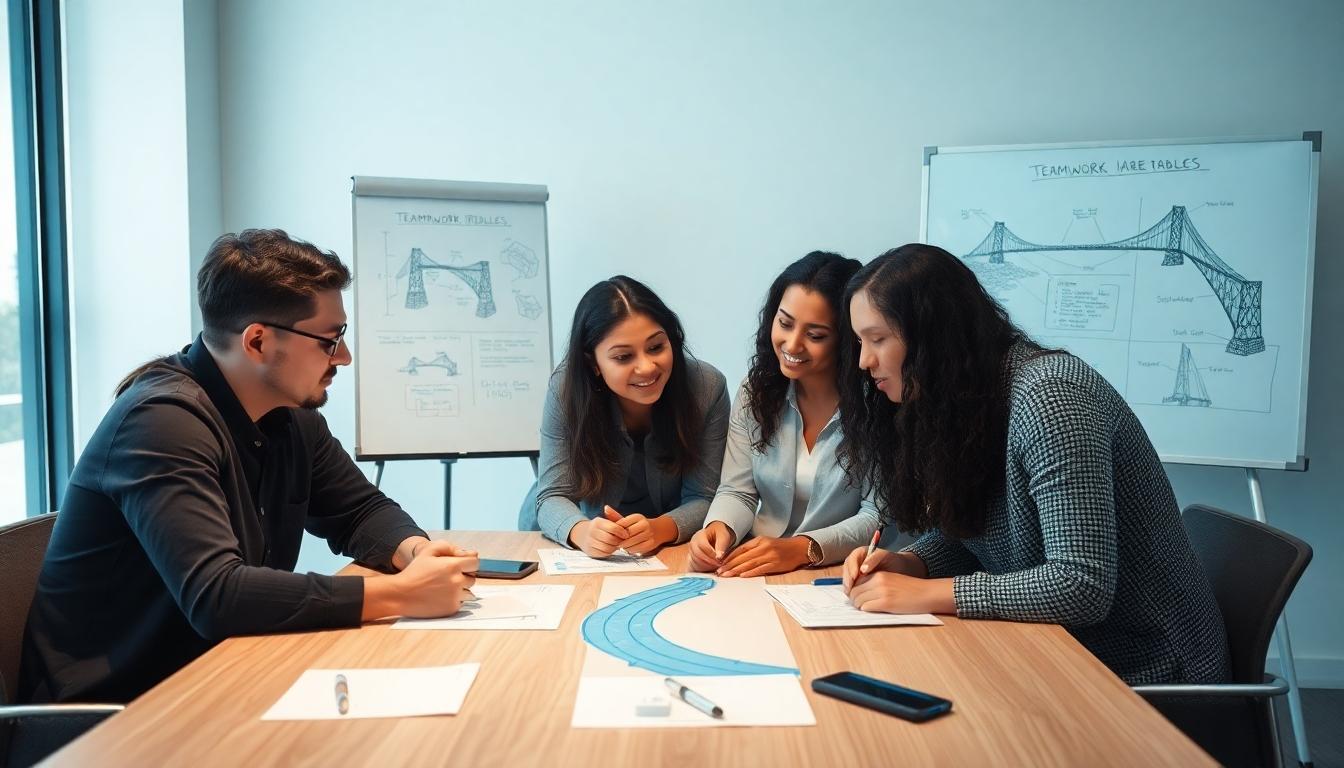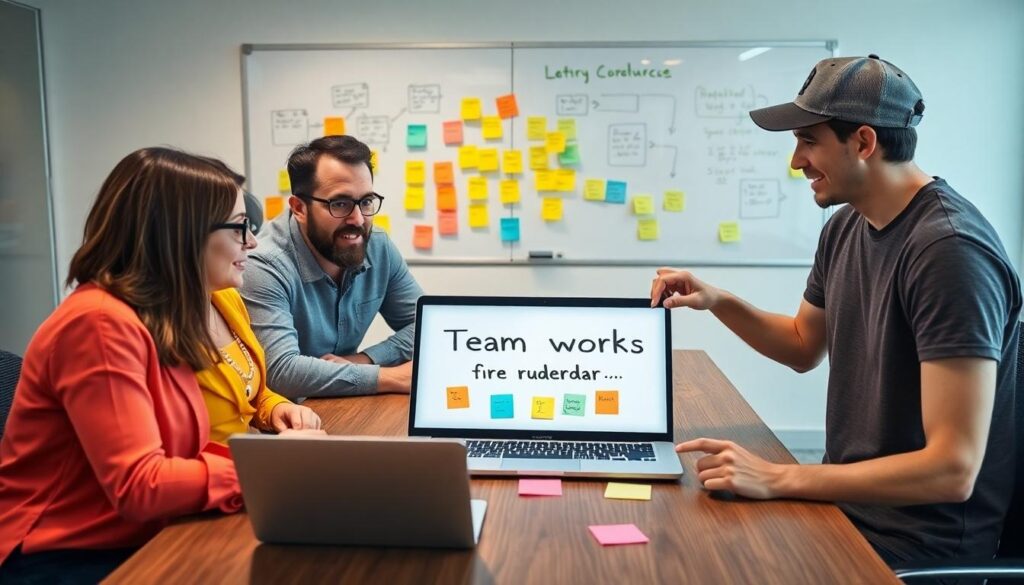Looking for a fun way to strengthen your team’s bonds and spark creative thinking? Teamwork riddles offer the perfect solution! These brain-teasing challenges require collaboration, communication, and collective problem-solving—all while providing an entertaining break from routine work activities.
We’ve compiled an exciting collection of teamwork riddles that’ll transform ordinary team-building sessions into memorable experiences. Whether you’re a manager seeking to boost morale, a teacher wanting to engage students, or a group leader planning an ice-breaker activity, these puzzles will get everyone’s minds working together. They’re designed to encourage participation from all personality types, bringing out hidden talents and creating moments of shared achievement when answers are discovered.
Fun Teamwork Riddles to Strengthen Your Group Dynamic
Teamwork riddles serve as excellent tools for fostering collaboration and critical thinking among team members. We’ve compiled a collection of captivating brain teasers that require collective problem-solving skills. These riddles range from simple to complex, making them perfect for teams at any experience level.
- The Broken Clock Riddle
A clock’s hands point to 12:15. What time will it show when the hour and minute hands swap positions?
Answer: 2:45
- The River Crossing Challenge
Four people need to cross a bridge at night with only one flashlight. Each person walks at different speeds: 1, 2, 5, and 10 minutes. Only two people can cross at once, and they must have the flashlight. How can they all cross in just 17 minutes?
Answer: The 1 and 2-minute people cross first (2 minutes). The 1-minute person returns (1 minute). The 5 and 10-minute people cross (10 minutes). The 2-minute person returns (2 minutes). The 1 and 2-minute people cross again (2 minutes). Total: 17 minutes.
- The Rope Burning Puzzle
You have two ropes that burn inconsistently. Each rope takes exactly 60 minutes to burn completely. How can you measure exactly 45 minutes using only these ropes and a lighter?
Answer: Light both ends of the first rope and one end of the second rope. When the first rope burns completely (30 minutes), light the other end of the second rope. The second rope will finish burning 15 minutes later, marking exactly 45 minutes.
- The Box of Marbles
You have 12 identical-looking marbles and a balance scale. One marble weighs slightly different than the others. How can you identify the odd marble with just three weighings?
Answer: Divide marbles into three groups of 4. Weigh group 1 vs group 2. If equal, the odd marble is in group 3. If not, take the heavier group. Then weigh 2 marbles vs 2 marbles from that group. If equal, weigh the remaining 2 to find the odd one. If not, weigh 1 vs 1 from the heavier pair.
- The Water Jug Problem
You have a 3-gallon jug and a 5-gallon jug. How can you measure exactly 4 gallons of water?
Answer: Fill the 5-gallon jug completely. Pour from it into the 3-gallon jug until full. The 5-gallon jug now has 2 gallons. Empty the 3-gallon jug and pour the 2 gallons from the 5-gallon jug into it. Fill the 5-gallon jug again and pour 1 more gallon into the 3-gallon jug (filling it). The 5-gallon jug now has exactly 4 gallons.
- The Light Bulb Puzzle
Three light switches are downstairs, and each connects to one of three light bulbs in an upstairs room. You can flip the switches as many times as you want while downstairs, but once you go upstairs, you cannot return. How do you determine which switch controls which bulb?
Answer: Turn switch 1 on for several minutes, then turn it off. Turn switch 2 on and leave it on. Go upstairs. The bulb that’s on connects to switch 2. The bulb that’s off but warm connects to switch 1. The bulb that’s off and cool connects to switch 3.
- The Missing Dollar Riddle
Three friends split a $30 hotel room bill, each paying $10. Later, the hotel realizes there was a mistake and the bill should only be $25. The bellhop returns $5 to the friends, who each take $1 and give the bellhop $2 as a tip. Each friend paid $9 ($10-$1), totaling $27, plus $2 tip equals $29. Where is the missing dollar?
Answer: This is a misdirection riddle. The correct calculation is: $25 (actual cost) + $3 (refunded to friends) + $2 (tip) = $30 (original payment). There is no missing dollar.
- The Prisoner Hat Riddle
Ten prisoners stand in a line, each wearing either a black or white hat. Each can see the hats of people in front but not their own or those behind. Starting from the back, each prisoner must guess their hat color. How can they maximize survival if a wrong guess means execution?
Answer: The last person counts the number of black hats visible. If odd, they say “black”; if even, “white.” Each subsequent prisoner counts visible black hats, adds one if the previous person said “black,” and determines their own hat color based on whether the total should be odd or even.
These riddles encourage team members to communicate effectively, share perspectives, and build upon each other’s ideas. Try incorporating these challenges into your next team-building session to enhance problem-solving capabilities and strengthen group bonds.
10 Brain-Teasing Riddles That Require True Collaboration

- “A man pushing his car to a hotel shouts, ‘I’m bankrupt!’ Why?”
The answer lies in board game strategy rather than real financial trouble. He’s simply playing Monopoly, where bankruptcy is just part of the game!
- “What has keys but can’t open locks?”
This classic riddle requires teams to think beyond the obvious. A piano has many keys but won’t help you unlock any doors.
- “I am strong when we work together, but weak alone. What am I?”
Perfectly embodying the essence of collaboration, the answer to this riddle is teamwork itself, highlighting how collective effort surpasses individual capability.
- “What has four wheels and flies?”
Teams must avoid literal thinking to solve this clever wordplay. A garbage truck has four wheels and attracts flies due to its contents.
- “What has multiple hands but can’t clap?”
Working together to consider various possibilities leads to the answer: a team has many hands but as a conceptual entity, cannot physically clap.
- “I have no beginning, end, or middle, but unite a team. What am I?”
This philosophical riddle encourages deep discussion about team dynamics and shared purpose.
- “The more I consume, the brighter I become. What am I?”
Teams must think metaphorically to discover that fire grows brighter as it consumes more fuel.
- “I speak without a mouth and hear without ears. What am I?”
This nature-inspired riddle reveals an echo as the answer, challenging teams to think beyond human capabilities.
- “What is essential for success but has no limit?”
Groups will debate various unlimited resources that drive achievement, making this an excellent discussion starter.
- “A farmer must transport a wolf, goat, and cabbage across a river. How?”
This sequential logic puzzle requires careful planning: take the goat first, return empty-handed, take the wolf across, bring the goat back, take the cabbage across, then finally return for the goat.
Communication-Based Riddles
Communication-based riddles excel at fostering active listening and idea exchange among team members. The riddle “What does everyone do at the same time?” prompts teams to consider universal human experiences, with the answer being “grow older” – something we all do continuously. Another captivating example asks “I live if I fall off a building but die in water. What am I?” Teams must share perspectives to realize that a shadow survives falls but disappears in water. These riddles create natural opportunities for group members to practice articulating their thoughts clearly while respectfully considering input from others.
Logic Puzzles for Team Problem-Solving
Logic puzzles demand systematic thinking and collaborative reasoning, making them perfect for developing team problem-solving capabilities. The piano keys riddle and the farmer’s river crossing challenge (mentioned above) exemplify how structured reasoning leads to elegant answers. Another thought-provoking example asks “What can be measured but not seen?” prompting teams to consider abstract concepts before arriving at the answer: time. These puzzles encourage methodical approaches where team members must build upon each other’s ideas, test hypotheses together, and refine their collective thinking process. The beauty of these challenges lies in how they naturally reveal different thinking styles within the group, allowing teams to leverage their cognitive diversity.
5 Classic Teamwork Riddles That Build Trust and Communication

These classic teamwork riddles have stood the test of time, challenging groups to think collectively and communicate effectively to reach answers.
The River Crossing Challenge
The River Crossing Challenge presents teams with a deceptively simple yet strategically complex problem. A farmer must transport a wolf, goat, and cabbage across a river using a boat that can only carry him and one item at a time. The critical constraint lies in the natural predator-prey relationships: if left alone, the wolf will eat the goat, and the goat will devour the cabbage. Teams must develop a transportation sequence that ensures nothing gets eaten.
The optimal solution requires careful planning and sequential thinking:
- First, take the goat across the river
- Return empty-handed to the original shore
- Transport either the wolf or cabbage next
- Bring the goat back to the starting point
- Take the remaining item (wolf or cabbage) across
- Return for the goat and complete the final crossing
This riddle brilliantly demonstrates the importance of strategic planning, prioritizing safety within a team, and solving complex problems through incremental steps.
The Four Campers’ Bridge Puzzle
In this time-sensitive challenge, four campers with varying crossing speeds (1, 2, 5, and 10 minutes) must traverse a fragile bridge at night. The constraints make this particularly challenging: only two people can cross at once, they need a single flashlight to see, and they move at the pace of the slower person.
The solution requires careful resource allocation and strategic pairing:
- The two fastest campers (1 and 2 minutes) cross first (taking 2 minutes)
- The fastest camper returns with the flashlight (adding 1 more minute)
- The two slowest campers (5 and 10 minutes) cross together (adding 10 minutes)
- The second-fastest camper brings back the flashlight (adding 2 more minutes)
- Both fast campers cross again (adding a final 2 minutes)
This approach completes the challenge in 17 minutes total, highlighting the importance of resource management and role delegation in effective teamwork.
The Locked Book Combination
Teams facing the Locked Book Combination must decipher a 3-digit code using only these cryptic clues:
- The first digit equals 4 times the second digit
- The third digit equals the first digit minus 3
- All three digits sum to 12
Through collaborative critical thinking, teams must systematically work through possible answers. Setting the second digit as x, they can establish that the first digit equals 4x and the third digit equals 4x – 3. Creating an equation: 4x + x + (4x – 3) = 12, which simplifies to 9x – 3 = 12, giving x = 1.67.
Since digits must be whole numbers, teams must reapproach the problem differently, eventually discovering the solution: 624 (which satisfies all conditions: 6 = 4 × 2, 4 = 6 – 3, and 6+2+4 = 12).
The Light Switch Dilemma
The Light Switch Dilemma tests observation skills and collaborative deduction. Teams encounter three switches outside a room, with only one chance to enter and determine which switch controls which light bulb inside.
The ingenious solution leverages physics knowledge:
- Turn on the first switch for about five minutes, then turn it off
- Turn on the second switch and leave it on
- Leave the third switch off entirely
- Enter the room and observe the light bulbs
The light that’s on corresponds to switch two. For the off lights, teams must touch them to feel their temperature. A warm bulb indicates it was recently on but now off (switch one), while a completely cold bulb connects to switch three.
The Unfaithful Spouse
This classic logical deduction puzzle involves a town where 25% of husbands are unfaithful, but no wife knows about her own husband’s fidelity. When a wise woman announces, “At least one husband in town is unfaithful,” a fascinating chain reaction begins.
The solution depends on logical deduction and counting days. If only one husband was unfaithful, his wife would deduce it immediately. With two unfaithful husbands, both wives would figure it out after one day of reflection. With three or more, the pattern continues with an additional day of deduction for each unfaithful husband.
This riddle powerfully demonstrates how deductive reasoning and group consensus building operate within teams facing complex problems with incomplete information.
Team-Building Riddles for Different Group Sizes

Tailoring team-building activities to your group size ensures maximum engagement and collaborative success. We’ve curated exact riddles that work best for different team configurations.
Small Team Riddles (3-5 People)
Small teams benefit from focused riddles that encourage intimate collaboration and quick decision-making. The Monopoly Scenario riddle asks, “A man pushing his car stops at a hotel and shouts, ‘I’m bankrupt!’ Why?” Teams must realize he’s playing Monopoly rather than experiencing a real-life situation. Another excellent option for compact groups is the Piano Riddle, which asks: “What has keys but can’t open locks?” This deceptively simple puzzle (answer: a piano) promotes lateral thinking in close-knit environments.
The River Crossing Logic puzzle presents a challenging scenario where teams must help a farmer transport a wolf, goat, and cabbage across a river when his boat only carries him and one item at a time. Teams need to collaborate closely to discover the correct sequence: taking the goat first, returning for the cabbage, bringing the goat back, taking the wolf, then finally retrieving the goat. These compact team challenges require efficient communication and strategic thinking, making them perfect for smaller groups that need to strengthen their problem-solving capabilities.
Large Group Collaborative Puzzles
Larger teams require riddles that help broader participation and role division. The Abstract Riddle asks, “What has branches but no fruit, leaves, or trunk?” This puzzle (answer: a bank) encourages multiple viewpoints and creative association from team members. Similarly, the Alphabet Challenge poses the question: “What word contains all 26 letters?” Teams often explore complex possibilities before realizing the answer is simply “alphabet,” showcasing how groups can sometimes overthink problems.
Activity-based challenges like the Egg Drop Puzzle work exceptionally well for big teams. Groups must build protective cages for raw eggs using only office supplies, then test their creations by dropping them from a height. This hands-on challenge naturally encourages role delegation, with some team members designing, others constructing, and still others presenting their answers. Large group riddles foster creativity while requiring structured collaboration, making them ideal for departments or cross-functional teams wanting to improve their collective problem-solving approaches.
Quick Teamwork Riddles for Icebreakers and Meetings

Looking for ways to energize your team meetings and foster collaboration? These quick teamwork riddles serve as perfect icebreakers that stimulate creative thinking while encouraging group problem-solving. We’ve gathered several captivating puzzles that can transform ordinary meetings into interactive sessions where team members connect and collaborate.
Simple Yet Effective Teamwork Riddles
- I am strong when we work together, but weak when we stand alone. What am I?
Answer: Teamwork
This riddle perfectly captures the essence of collaboration, reminding teams that their collective strength far exceeds individual efforts.
- What has multiple hands but cannot clap?
Answer: A team
Teams have many hands working toward common goals, yet require coordination to function effectively—just like hands need each other to clap.
- I am made up of many, yet function as one.
Answer: A team or an organization
Organizations comprise many individuals who align their efforts to operate as a cohesive unit, demonstrating the power of unity.
- What can bring a group of individuals together to achieve a common goal, but falls apart when one member is missing?
This riddle highlights the importance of each team member’s contribution and how absence can affect the entire group ever-changing.
Themed Riddles for Team Development
These riddles focus on exact aspects of teamwork that managers and team leaders want to emphasize:
- Collaboration and Unity Riddles: These puzzles emphasize the strength found in working together and how team members rely on each other for success.
- Problem-Solving Challenges: Classic scenarios like the farmer, wolf, and cabbage river crossing illustrate strategic thinking and collaborative problem-solving.
Using these quick riddles at the beginning of meetings can break the ice and spark meaningful discussions, creating an atmosphere conducive to productive teamwork. They require minimal setup time while delivering maximum engagement, making them ideal for busy professionals looking to enhance team cohesion.
Advanced Teamwork Riddles for Experienced Teams

When teams have mastered the basics of collaboration, they’re ready for more sophisticated challenges that test their collective problem-solving abilities. We’ve compiled a selection of advanced teamwork riddles specifically designed for experienced teams looking to elevate their collaborative skills to the next level.
Complex Logic Puzzles
River Crossing with Multiple Constraints
This challenging puzzle requires careful coordination and strategic thinking. Four campers must cross a fragile bridge at night where only two people can cross simultaneously while sharing a single flashlight. Each camper moves at different speeds: 1, 2, 5, and 10 minutes respectively. The key twist is that pairs must move at the slower person’s pace. Teams must determine how to get everyone across in minimal time.
Solution: The optimal strategy involves using the fastest campers (1 and 2 minutes) to shuttle the flashlight back and forth. Following the right sequence allows all campers to cross in just 17 minutes.
Combination Lock Puzzle
Teams must crack a three-digit combination lock using logical deduction. The clues include: the first digit equals four times the second digit; the third digit is three less than the first; and all three digits sum to exactly 12.
Solution: The correct combination is 6-2-4. This works because 6 is four times 2; 4 is indeed 3 less than 6; and 6+2+4 equals 12.
Collaborative Problem-Solving Riddles
Resource Allocation Challenge
This classic riddle with a twist forces teams to think several steps ahead. A farmer needs to transport a wolf, a goat, and a cabbage across a river in a boat that can only hold the farmer plus one item. The constraint? If left unsupervised together, the wolf will eat the goat, and the goat will eat the cabbage.
Solution: The farmer must take the goat first, return empty-handed, take the cabbage next, bring the goat back, take the wolf across, return empty-handed, and finally transport the goat again.
Unconventional Answer Riddles
These brain teasers require teams to think metaphorically and break conventional thought patterns:
- “I have keys but open no locks. I have space but no room. You can enter, but you can’t go inside. What am I?”
Answer: A piano
- “What speaks without a mouth and hears without ears?”
Answer: An echo
Team-Building Applications
Many companies incorporate these advanced riddles into structured activities like the Marshmallow Spaghetti Tower challenge, where teams must build the tallest free-standing structure using only spaghetti, string, tape, and a marshmallow on top. Time constraints add pressure that mimics real-industry project deadlines.
Logical puzzles like the bridge crossing scenario teach strategic delegation, encouraging teams to assign roles based on individual strengths. Abstract riddles enhance creative communication skills by forcing team members to express complex concepts clearly.
These sophisticated teamwork riddles deliver multiple benefits for experienced teams, including enhanced lateral thinking capabilities, improved role specialization awareness, and strengthened collective problem-solving abilities under pressure. The complexity of these challenges ensures that no single team member can solve them alone, reinforcing the value of diverse perspectives and collaborative effort.
How to Facilitate Teamwork Riddles for Maximum Engagement

Setting Clear Rules and Guidelines
When facilitating teamwork riddles, establishing clear rules and guidelines creates a structure that maximizes participation and effectiveness. We recommend starting with defined time limits for each riddle to encourage quick thinking and prevent the activity from dragging. Team size should be carefully determined beforehand to ensure optimal group dynamics—typically 3-5 members works well for most riddle challenges. Adjusting the riddle complexity to match your team’s skill level is crucial; puzzles should be challenging enough to engage participants but not so difficult that they become frustrating. This balanced approach keeps team members motivated and focused on collaborative problem-solving throughout the activity.
Debriefing for Learning Opportunities
The value of teamwork riddles extends far beyond the solving experience, with debriefing sessions offering rich learning opportunities. We encourage facilitators to gather teams after completing riddles to discuss their problem-solving strategies and collaborative approaches. Teams should share which techniques proved effective and how they overcame challenges together. Identifying key lessons about communication patterns, creative thinking, and collaboration styles helps participants translate these insights to workplace scenarios. Creating a constructive feedback loop allows team members to express what worked well and suggest improvements for future activities. This reflective practice transforms a simple riddle exercise into a meaningful team development opportunity with lasting impact.
Choosing Relevant Riddles
Selecting the right riddles significantly impacts engagement and learning outcomes for your team. We find that puzzles like “The Farmer’s Dilemma,” where a farmer must transport a wolf, goat, and cabbage across a river with exact constraints, effectively highlight resource allocation and strategic thinking. The “Monopoly Bankruptcy” riddle—where a hotel guest shouts about bankruptcy while moving his car—demonstrates how contextual understanding affects problem-solving. Choose riddles that align with skills your team needs to develop, whether that’s logical reasoning, creative thinking, or communication. These carefully selected challenges not only entertain participants but also reinforce exact team capabilities that transfer directly to workplace collaboration and innovation.
Customizing Teamwork Riddles for Different Professional Settings

Teamwork riddles can be effectively customized to match various professional environments, ensuring maximum relevance and engagement for your exact team. By customizing these brain teasers to align with particular workplace cultures and skill sets, we can create more impactful team-building experiences that resonate with participants.
Technical Teams (e.g., Coders, Engineers)
Technical professionals typically thrive on analytical challenges that exercise their problem-solving muscles. For these teams, we recommend implementing logic and mathematical riddles that appeal to their systematic thinking processes. A perfect example is the classic river crossing puzzle: “A farmer needs to move a wolf, a goat, and a cabbage across a river. The boat can only hold the farmer and one item at a time. How does he do it?” This riddle requires methodical thinking and careful sequencing—skills that technical teams use daily.
Double entendres and puns also work surprisingly well with technical teams, adding a layer of linguistic creativity to their analytical mindset. Consider this example: “A man is pushing his car when he comes to a hotel and shouts, ‘I’m bankrupt!’ Why?” The answer—”He’s playing Monopoly”—combines logical deduction with a clever twist that technical minds appreciate.
Creative Teams (e.g., Designers, Writers)
Creative professionals benefit from riddles that spark imagination and encourage thinking beyond conventional boundaries. Abstract riddles work exceptionally well for these teams, challenging them to make unexpected connections between seemingly unrelated concepts.
Short story riddles provide excellent opportunities for creative teams to exercise their narrative thinking skills. These extended puzzles often contain subtle clues embedded within a storyline, requiring teams to pay attention to details while imagining possible scenarios—precisely the skills that designers and writers employ in their daily work.
Cross-Functional Teams
Teams comprising members from various departments require riddles that bridge different thinking styles and knowledge bases. Historical and cultural riddles serve as excellent tools for promoting diversity and inclusion within cross-functional groups, as they draw on varied knowledge domains and perspectives.
Short, clever riddles function perfectly as quick icebreakers for cross-functional team meetings. For instance, asking “What day is yesterday’s tomorrow and tomorrow’s yesterday?” (Answer: Today) creates an accessible entry point for all team members regardless of their professional background. These simple but captivating puzzles help establish common ground before diving into more complex collaborative tasks.
By thoughtfully selecting riddles that match your team’s professional context, we can enhance collaboration, stimulate creative problem-solving, and strengthen communication skills in ways that feel natural and relevant to your exact workplace environment. The key is choosing challenges that reflect the thinking patterns and skills that your team already values while gently stretching their collaborative capabilities.
Digital Teamwork Riddles for Remote Teams

Remote work demands innovative approaches to team building, and digital teamwork riddles offer the perfect solution for virtual teams seeking engagement without physical proximity. These specially designed challenges leverage wordplay and collaborative problem-solving to break the monotony of online meetings while fostering meaningful team interactions. Unlike traditional team-building activities, these riddles require no special equipment beyond standard video conferencing tools, making them both accessible and cost-effective.
Virtual Compatibility
Digital teamwork riddles excel in remote environments because they’re specifically designed for platforms like Zoom and other virtual meeting spaces. Teams can participate regardless of their global location, ensuring inclusive experiences for distributed workforces. Screen-sharing capabilities allow real-time collaboration on visual puzzles, while chat features enable quick communication during word-based challenges.
Skill Development
Each digital riddle serves as more than just entertainment—they’re carefully crafted learning opportunities. Communication skills improve as team members articulate their thought processes and actively listen to colleagues’ perspectives. Pattern recognition abilities sharpen when groups collectively analyze clues and potential answers. Creative problem-solving flourishes in these collaborative spaces where diverse thinking styles combine to tackle complex challenges.
Cultural Impact
Remote teams often struggle with building cohesive cultures across distance barriers. Teamwork riddles bridge these gaps by highlighting the diverse strengths present within cross-functional teams. Engineers might excel at logic-based challenges while marketing professionals might spot creative connections others miss. These shared experiences strengthen collaboration and foster mutual respect among team members with different backgrounds and expertise.
Examples
Try incorporating these effective digital riddles into your next virtual meeting:
- Wordplay Challenges: “What has keys but can’t open locks? A keyboard” – perfect for quick engagement without complex setup
- Logic Puzzles: Present a series of clues that team members must piece together via chat or verbal discussion
- Collaborative Jigsaws: Use screen-sharing to display digital puzzles that require coordinated effort to complete within time limits
- Pattern Recognition Games: Share sequences where teams must identify the underlying rule through collaborative analysis
These activities work exceptionally well as warm-ups before brainstorming or strategy sessions, helping team members transition into collaborative thinking modes. By integrating riddles into virtual meeting agendas, remote teams can effectively balance productivity requirements with engagement needs, creating more ever-changing and connected virtual workspaces.
Famous Teamwork Riddles That Have Stumped Even the Best Groups

Throughout history, certain teamwork riddles have challenged even the most cohesive groups, requiring exceptional collaboration to solve. These brain-teasers don’t just entertain—they truly test a team’s problem-solving abilities and communication skills.
The Monopoly Bankruptcy Challenge
“A man shouts ‘I’m bankrupt!’ after pushing his car to a hotel. Why?” This classic riddle stumps teams because it requires creative thinking outside typical contexts. The answer lies in understanding that the scenario describes someone playing Monopoly. Many groups overthink this puzzle, searching for complex explanations rather than recognizing the board game connection. This riddle brilliantly demonstrates how teams must consider unconventional perspectives to reach answers.
The Piano Keys Conundrum
“What has keys but can’t open locks?” Teams frequently struggle with this metaphorical riddle because members often fixate on physical keys. The answer—a piano—highlights how different interpretations can exist within a group. This riddle showcases the importance of diverse thinking styles in problem-solving scenarios. Teams that successfully solve this puzzle typically embrace multiple viewpoints rather than committing to a single approach.
The Farmer’s River Crossing Dilemma
The river crossing puzzle presents important collaborative challenges: a farmer must transport a wolf, goat, and cabbage across a river without leaving conflicting pairs alone. This seemingly simple scenario requires sequential planning and strategic thinking. Teams often fail when they don’t thoroughly discuss the consequences of each potential move. Successful groups typically map out the entire sequence before attempting a solution, highlighting the value of methodical collaboration.
The Teamwork Essence Riddle
“I am strong when we work together, but weak when we stand alone. What am I?” Though seemingly straightforward, this riddle often catches teams off guard with its self-referential nature. The answer—teamwork itself—serves as a powerful reminder of the concept being practiced. Groups frequently overlook this answer precisely because they’re actively engaged in teamwork while solving it, demonstrating how we sometimes miss what’s directly in front of us.
The Garbage Truck Analogy
“What has four wheels and flies?” This structural teamwork analogy confuses many groups because it plays on the dual meaning of “flies.” The answer—a garbage truck—illustrates how components function cohesively within a system. Teams that solve this riddle successfully typically excel at lateral thinking and considering multiple meanings of words. This puzzle exemplifies how effective teams can shift perspectives quickly when initial approaches prove unsuccessful.
The Timeless Team Challenge
“I am measured but not seen.” This abstract riddle references time—a critical element in all team projects. Groups often struggle with this puzzle because they focus on tangible measurements rather than conceptual ones. Teams that successfully navigate this riddle demonstrate their ability to think beyond the concrete, an essential skill for innovation and creative problem-solving. The solution emphasizes how shared deadlines and time management form the invisible foundation of successful teamwork.
Conclusion: The Lasting Impact of Teamwork Riddles on Group Cohesion
Teamwork riddles offer far more than momentary entertainment—they’re powerful tools that transform ordinary teams into collaborative powerhouses. We’ve seen how these brain teasers foster communication strengthen problem-solving skills and reveal diverse thinking styles that might otherwise remain hidden.
Whether you’re leading a small technical team a large creative department or a cross-functional group these riddles can be customized to your exact needs. The beauty lies in their versatility and accessibility—from quick icebreakers to complex challenges.
By implementing these captivating puzzles with clear guidelines and thoughtful debriefing you’ll create memorable experiences that translate directly to workplace success. So gather your team pick a riddle and watch as collaboration innovation and team spirit flourish before your eyes.
Frequently Asked Questions
What are teamwork riddles?
Teamwork riddles are brain-teasing challenges designed specifically to promote collaboration and communication among team members. They serve as engaging activities that require collective problem-solving skills while providing a fun break from regular work tasks. These riddles range from simple to complex and help strengthen team bonds while enhancing creative thinking.
How do teamwork riddles benefit a team?
Teamwork riddles enhance communication skills, promote collaborative problem-solving, reveal different thinking styles within the group, strengthen team bonds, and provide a refreshing break from routine work. They also help team members learn to leverage their cognitive diversity, improve active listening, and develop strategic planning skills—all in an entertaining format that boosts morale.
What are some examples of teamwork riddles?
Popular examples include the Broken Clock Riddle, River Crossing Challenge, Rope Burning Puzzle, Monopoly Bankruptcy Challenge, Piano Keys Conundrum, and the Farmer’s River Crossing Dilemma. These riddles vary in complexity and style, requiring teams to communicate effectively, share perspectives, and build upon each other’s ideas to arrive at solutions.
How should I facilitate teamwork riddles for maximum engagement?
Set clear rules with defined time limits and appropriate team sizes. Choose riddles relevant to the skills your team needs to develop. After completing the riddle, conduct a debriefing session where team members can reflect on their problem-solving strategies and communication patterns. This helps translate the experience into valuable workplace insights.
Can teamwork riddles be customized for different professional settings?
Yes, riddles can be tailored to different work environments. Technical teams benefit from analytical challenges, creative teams thrive on abstract riddles, and cross-functional teams do well with puzzles that bridge diverse knowledge bases. Customizing riddles to match your team’s professional context enhances relevance, engagement, and skill development.
Are teamwork riddles suitable for teams of all sizes?
Yes, but they should be adapted accordingly. Small teams (3-5 people) benefit from focused riddles like the Monopoly Scenario that promote intimate collaboration. Larger teams do better with structured collaborative puzzles like the Egg Drop Puzzle that allow for broader participation while maintaining engagement from all members.
How long should a teamwork riddle activity last?
Quick riddles can serve as 5-10 minute icebreakers at the beginning of meetings. More complex team-building activities might last 20-45 minutes, including time for solving and debriefing. The duration should match your available time and the complexity of the riddle while ensuring there’s sufficient opportunity for meaningful collaboration.
What makes for an effective teamwork riddle?
An effective teamwork riddle requires genuine collaboration rather than individual effort, has a clear but challenging solution, encourages communication, reveals different thinking styles, and ideally connects to workplace skills. The best riddles are engaging, appropriate for your team’s experience level, and yield insights about how team members work together.







